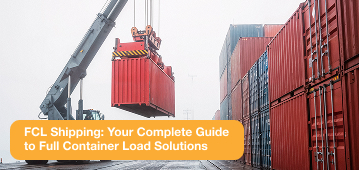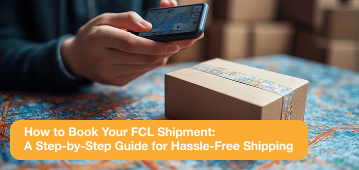Container Freight Station: Meaning, Functions and Role in Shipping
Previously, the goods were sorted during onboarding while loading the smaller shipments. This process frequently resulted in the mingling of all the goods/products. Containerized shipping, on the other hand, allows goods to be classified and organized before they are loaded. By optimizing the process of how shipments are onboarded, the containerized system has transformed how international shipping operates. CFS, or “Container Freight Stations,” aid in the consolidation of smaller shipments, or Less Container Load (LCL), and thus play an important role in the containerized shipping process.
What is Container Freight Station (CFS)?
It is a warehouse station in charge of cargo consolidation or deconsolidation before products/goods are imported or exported. The CFS is a location where goods are stored before and after loading and unloading cargo.
When it comes to LCL, the cargo is loaded into one container and brought to a CFS to be consolidated before the goods are shipped to their destination.
The CFS is run by a shipping line or terminal, and its warehouse is near the port or shipping terminal. These stations are also in charge of customs clearance procedures and shipment documentation. It is a customs-notified zone where all transactions are subject to customs authentication. A Customs House Agent (CHA) is the primary point of contact between container freight stations and the parties involved in the transaction.
Why Choose a Container Freight Station?
A Container Freight Station or CFS will help facilitate intermodal transport for your cargo with adequate safety measures and tracking. CFS plays an important role in optimizing the process of sending smaller shipments to their respective locations. Here are a few reasons why CFS service is so important in import and export logistics:
· Goods are consolidated into various types of containers at the CFS, and each vessel is assigned a unique identification number, allowing the trader to track the container and the product.
· Containerized goods sent via CHS reduce the risk of damage, facilitating a smooth transaction between the exporter and importer.
· A proper list is kept, which includes the importer/name, exporter’s CHA agent name/house, product, onboarding/unloading port, product name, truck number, shipping line, quantity, size, and so on.
· At the gateway ports, customs clearance is not required.
· Because CHS acts as a concentration point for smaller shipments, it helps to reduce empty container movement, making LCL shipments more cost-effective.
· Dock port automation for container loading and unloading.
Role of CFS in Import
Container freight stations are used for both embankment and disembarkation of goods from the point of origin (export) to the destination (import). The steps taken by CFS during import and export are detailed below:
CFS’s Role in Importing Goods CFS functions as an extension of a port. When importing goods, they can be sent directly to the CFS rather than directly from the port, significantly reducing port congestion.
For example, Company ABC in India is receiving a shipment from Company XYZ in the United States. The exporter will prepare the necessary export documents and notify the CHA house accordingly. When the goods arrive at the port, they are transferred to the CFS, and the subsequent processes are carried out –
Step 1: Customs inspects the goods at the Indian port before stacking them at the station.
Step 2: Before transporting the cargo to CFS, the steamer agents/liners/importers must file the Import General Manifest at the port.
Step 3: The CFS then de-stuffs the containers’ contents.
Step 4: The CHA/Importer must file a Bill of Entry with customs, after which the goods will be assessed, and duty paid.
Step 5: Following customs clearance, the department issues an “out of charge” order, and the goods are released from the CFS to the trader with a “gate pass.”
Read More: [The Ultimate Guide to Less Than Container Load (LCL) Shipping: Definition, Benefits & Drawbacks]
Role of CFS in Export
As previously stated, a CFS oversees consolidating cargo and stuffing it into containers before the goods are shipped. This procedure reduces congestion at the port of origin and ensures that the cargo is shipped as efficiently as possible.
For example, if Company ABC from India ships Company XYZ in the United States, the CFS export procedure will be as follows:
Step 1: The exporter will load the goods onto a truck and deliver them along with the shipping bill to the designated CFS.
Step 2: The goods will then go through the loading and carting process.
Step 3: In the warehouse, the goods will be scanned and verified before being stuffed into containers.
Step 4: The customs officer seals the container and transports it from the CFS to the port.
Step 5: Once the goods arrive at the port, they are dispatched via the shipping line (the shipping line is the company decided by the party for processing the shipment).
What are the primary responsibilities of a Container Freight Station?
The following are the major freight station accomplishments:
· Receiving and delivering cargo
· Cargo consolidation and deconsolidation (for LCL shipments)
· Export container stuffing and import container de-stuffing or stripping
· Temporary storage for cargo and laden or empty containers, as well as transit or re-export.
· Rail/road transportation to and from ports
· Customs authorities examine and assess export-import shipments for customs clearance.
· System for tracking containers or cargo
The distinction between CFS, ICD, Container Yard, and Bonded Warehouse
An ICD, or Inland Container Depot, is a type of transit facility like a CFS. However, ICDs are mostly found in the country’s interior, whereas a CFS is a customs space near sea/ocean ports.
An ICD can operate as a separate entity, whereas the CFS falls under the jurisdiction of the customs house.
A bonded warehouse stores goods that have already been cleared by customs. The goods brought into CFS, on the other hand, must go through customs verification and clearance.
In shipping, a Container Yard (CY) is a designated area at the port where FCL containers are brought and stored before being loaded onto the ship. While CFS has the same functionality, the station only handles LCL shipments rather than FCL.
FAQ
What is CFS Shipping?
CFS (Container Freight Station) Shipping involves handling and consolidating cargo at a facility before it is loaded into containers for transport.
What is the difference between FCL & CFS?
FCL (Full Container Load) means an entire container is used by one shipment, while CFS (Container Freight Station) involves consolidating smaller shipments into a shared container.
Why is CFS important in logistics?
CFS is crucial for efficient cargo handling, consolidation, and deconsolidation, facilitating better space utilization, and enabling smoother customs processing.
What does CFS mean in freight?
In freight, CFS refers to a facility where cargo is consolidated into or deconsolidated from containers, playing a vital role in logistics and supply chain management.
What is CFS Shipment?
A CFS shipment involves consolidating various smaller consignments at a Container Freight Station before shipping, optimizing space and cost efficiency in logistics.
Like
Related Blogs

FCL Shipping: Your Complete Guide to Full Container Load Solutions

FCL Container Size and Dimensions: A Complete Guide



ecu360.com
ecu360.com
ecu360.com
best ecu360.com
best ecu360.com
ecu360.com
best ecu360.com
best ecu360.com
best ecu360.com
best ecu360.com
best ecu360.com
best ecu360.com
ecu360.com
ecu360.com
ecu360.com
ecu360.com
Container Freight Station: Meaning, Functions and Role in Shipping
Container Freight Station: Meaning, Functions and Role in Shipping
Container Freight Station: Meaning, Functions and Role in Shipping
Container Freight Station: Meaning, Functions and Role in Shipping
Container Freight Station: Meaning, Functions and Role in Shipping
Container Freight Station: Meaning, Functions and Role in Shipping
Container Freight Station: Meaning, Functions and Role in Shipping
Container Freight Station: Meaning, Functions and Role in Shipping
Container Freight Station: Meaning, Functions and Role in Shipping
Container Freight Station: Meaning, Functions and Role in Shipping
Container Freight Station: Meaning, Functions and Role in Shipping
Container Freight Station: Meaning, Functions and Role in Shipping
Container Freight Station: Meaning, Functions and Role in Shipping
Container Freight Station: Meaning, Functions and Role in Shipping
Container Freight Station: Meaning, Functions and Role in Shipping
Container Freight Station: Meaning, Functions and Role in Shipping
Hello ecu360.com webmaster, Your posts are always thought-provoking and inspiring.
Regan Goldberg
Rita Bautista
Wendi Backhaus
Britney Ritchie
Catherine Pidgeon
Shelly Tarenorerer
Caitlyn Gentile
Trinidad Childers
Doreen Reel
Miriam Dawes
Sabine Follett
Marta Huerta
Carin Hope
Cary Paramore
Silas Neal
Manuel Myrick
Basil Fewings
Hello ecu360.com webmaster, Your posts are always well written.
Hello ecu360.com administrator, Your posts are always well-referenced and credible.
Hello ecu360.com administrator, Your posts are always well thought out.
Vania Copley
Arthur Lillibridge
Bonita Matteson
Holley McKerihan
Vince Kastner
To the ecu360.com administrator, Your posts are always well-formatted and easy to read.
To the ecu360.com webmaster, Your posts are always on topic and relevant.
Ryan Clem
Eliza Brodzky
Rogelio Harry
Carina Tejeda
Adelaide Anderton
Bertie Lockington
Cecila Hyatt
Leroy Tietkens
Stanley Arent